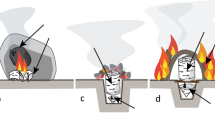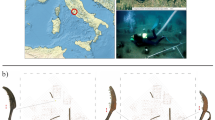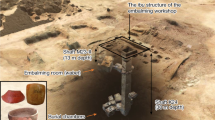Abstract
The raising of the wreck of King Henry VIII's flagship (AD 1509–45), the Mary Rose, from the bed of the Solent was a unique event, notable as a significant technical achievement in naval architectural history and as a source of well-preserved Tudor relics. Preservation is attributed to the anaerobic environment prevailing within the sediment during much of the period of burial and, in some cases, to the large quantities of pitch that permeated the ship and many of the relics. Although the function of many relics is usually easily recognized, their means of construction and the nature and origin of the materials used in their manufacture are often much less obvious. We report here the chemical analysis of six samples of pitch from the Mary Rose. Computerized gas chromatography/mass spectrometry (CGC/MS) and infrared spectroscopy have been used to ‘fingerprint’ the pitches and compare them with modern-day tars and pitches derived from wood, coal, peat and petroleum. Diterpenoid hydrocarbons, methyl dehy-droabietate and dehydroabietic acid were found in similar proportions to ‘Stockholm tar (good-quality pine tar obtained by the destructive distillation of Pinus sylvestris), so providing conclusive evidence for the derivation of the Mary Rose pitches from pine wood.
This is a preview of subscription content, access via your institution
Access options
Subscribe to this journal
Receive 51 print issues and online access
$199.00 per year
only $3.90 per issue
Buy this article
- Purchase on Springer Link
- Instant access to full article PDF
Prices may be subject to local taxes which are calculated during checkout
Similar content being viewed by others
References
Goffer, Z. Archaeological Chemistry (Wiley, Chichester, 1980).
Thornton, M. D., Morgan, E. D. & Celoria, F. Science and Archaeology 2–3, 20–24 (1970).
Morgan, E. D., Titus, L., Small, R. J. & Edwards, C. Arctic 36, 356–360 (1983).
Rottlander, R. C. A. & Schlichtherle, H. Archaeophysika 10, 260–267 (1979).
Cassar, M., Robins, G. V., Fletton, R. A. & Alstin, A. Nature 303, 238–239 (1983).
Plahter, U. Saertrykk Fra, Universitetets Oldsaksamlings Arbok, 217–219 (1969).
Mills, J. S. & White, R. Stud. Conserv. 22, 12–31 (1977); Natn. Gallery tech. Bull. 6, 3–18 (1982).
White, R. & Castle, S. A. Britannia 9, 383–392 (1978).
Simoneit, B. R. T. thesis, Univ. Bristol (1975).
Thomas, B. R. in Organic Geochemistry-Methods and Results (eds Eglinton, G. & Murphy, M. T. J.) 599–618 (Springer, Berlin, 1969).
Thomas, B. R. in Phytochemical Phylogeny (ed. Harborne, J. B.) Ch. 4, (Academic, New York, 1970).
Forbes, R. J. Bitumen and Petroleum in Antiquity, 1–31 (Brill, Leiden, 1936).
Danischewsky, M. I. Post-Medieval Archaeology Vol. 9, 77–78 (Society for Post-Medieval Archaeology, 1975).
Meiggs, R. Trees and Timber in the Ancient Mediterranean World (Clarendon, Oxford, 1982).
Jerman, K. thesis, Univ. Bristol (1984).
Author information
Authors and Affiliations
Rights and permissions
About this article
Cite this article
Evershed, R., Jerman, K. & Eglinton, G. Pine wood origin for pitch from the Mary Rose. Nature 314, 528–530 (1985). https://doi.org/10.1038/314528a0
Received:
Accepted:
Issue Date:
DOI: https://doi.org/10.1038/314528a0
This article is cited by
-
Multi-proxy analysis of starchy plant consumption: a case study of pottery food crusts from a Late Iron Age settlement at Pada, northeast Estonia
Vegetation History and Archaeobotany (2023)
-
Pyrotechnology and lipid biomarker variability in pine tar production
Archaeological and Anthropological Sciences (2023)
-
Molecular and crystal structures of cellulose in severely deteriorated archaeological wood
Cellulose (2022)
-
A multi-analytical approach for the identification of the natural resin from the Ming tomb in Shaanxi, China
Heritage Science (2021)
-
Birch Bark Tar Production: Experimental and Biomolecular Approaches to the Study of a Common and Widely Used Prehistoric Adhesive
Journal of Archaeological Method and Theory (2019)
Comments
By submitting a comment you agree to abide by our Terms and Community Guidelines. If you find something abusive or that does not comply with our terms or guidelines please flag it as inappropriate.



